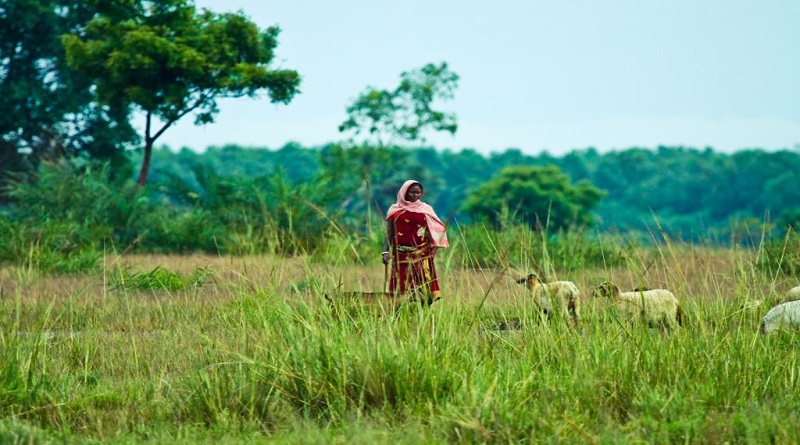‘Silent demise’ of vast rangelands threatens climate, food, wellbeing of billions: UNCCD
Degradation of Earth’s extensive, often immense natural pastures and other rangelands due to overuse, misuse, climate change and biodiversity loss poses a severe threat to humanity’s food supply and the wellbeing or survival of billions of people, the UN warns in a stark report on Tuesday 21 May 2024.
Authors of the Global Land Outlook Thematic Report on Rangelands and Pastoralists, launched in Ulaanbaatar, Mongolia by the UN Convention to Combat Desertification (UNCCD), say up to 50% of rangelands are degraded.
Symptoms of the problem include diminished soil fertility and nutrients, erosion, salinization, alkalinization, and soil compaction inhibiting plant growth, all of which contribute to drought, precipitation fluctuations, and biodiversity loss both above and below the ground.
The problem is driven largely by converting pastures to cropland and other land use changes due to population growth and urban expansion, rapidly rising food, fibre and fuel demands, excessive grazing, abandonment (end of maintenance by pastoralists), and policies that incentivise overexploitation.
What are rangelands?
The rangelands category of Earth’s land cover consists mostly of the natural grasslands used by livestock and wild animals to graze and forage.
They also include savannas, shrublands, wetlands, tundra and deserts.
Added together, these lands constitute 54% of all land cover, account for one sixth of global food production and represent nearly one third of the planet’s carbon reservoir.
“When we cut down a forest, when we see a 100-year-old tree fall, it rightly evokes an emotional response in many of us. The conversion of ancient rangelands, on the other hand, happens in ‘silence’ and generates little public reaction,” says UNCCD Executive Secretary Ibrahim Thiaw.
“Sadly, these expansive landscapes and the pastoralists and livestock breeders who depend on them, are usually under-appreciated,” Mr. Thiaw adds. “Despite numbering an estimated half a billion individuals worldwide, pastoralist communities are frequently overlooked, lack a voice in policy-making that directly affects their livelihoods, marginalised, and even often seen as outsiders in their own lands.”
Mongolia Environment Minister H.E. Bat-Erdene Bat-Ulzii says: “As custodian of the largest grasslands in Eurasia, Mongolia has always been cautious in transforming rangelands. Mongolian traditions are built on the appreciation of resource limits, which defined mobility as a strategy, established shared responsibilities over the land, and set limits in consumption. We hope this report helps focus attention on rangelands and their many enormous values – cultural, environmental, and economic – which cannot be overstated. If these rangelands cannot support these massive numbers of people, what alternatives can they turn to?”
Mongolia will host the 17th UNCCD Conference of the Parties meeting in 2026, the International Year of Rangelands and Pastoralists (IYRP), declared by the United Nations General Assembly on Mongolia’s initiative.
Two billion people – small-scale herders, ranchers and farmers, often poor and marginalised – depend on healthy rangelands worldwide.
Indeed, in many West African states, livestock production employs 80% of the population. In Central Asia and Mongolia, 60% of the land area is used as grazing rangelands, with livestock herding supporting nearly one third of the region’s population.
Ironically, the report underlines, efforts to increase food security and productivity by converting rangelands to crop production in mostly arid regions have resulted in degraded land and lower agricultural yields.
The report calls out “weak and ineffective governance,” “poorly implemented policies and regulations,” and “the lack of investment in rangeland communities and sustainable production models” for undermining rangelands.
An innovative approach
The new report’s 60+ expert contributors from over 40 countries agree that past estimates of degraded rangeland worldwide – roughly 25% – “significantly underestimates the actual loss of rangeland health and productivity” and could be as much as 50%.
Rangelands are often poorly understood and a lack of reliable data undermines the sustainable management of their immense value in food provisioning and climate regulation, the report warns.
The report details an innovative conceptual approach that would enable policy-makers to stabilise, restore and manage rangelands.
The new approach is backed by experience detailed in case studies from nearly every world region, drawing important lessons from successes and missteps of rangeland management.
A core recommendation: protect pastoralism, a mobile way of life dating back millennia centred on the pasture-based production of sheep, goats, cattle, horses, camels, yaks, llamas or other domesticated herbivores, along with semi-domesticated species such as bison and reindeer.
Says Mr. Thiaw: “From the tropics to the Arctic, pastoralism is a desirable default – and often the most sustainable – option for that should be incorporated into rangeland use planning.”
The economic engine of many countries
Rangelands are an important economic engine in many countries and define cultures. Home to one quarter of the world’s languages, they also host numerous World Heritage Sites and have shaped the value systems, customs and identities of pastoralists for thousands of years.
The report includes detailed analyses of individual countries and regions.
For example, livestock production accounts for 19% of Ethiopia’s GDP, and 4% of India’s. In Brazil – which produces 16% of the world’s beef – fully one-third of agribusiness GDP is generated by cattle livestock.
In Europe, many rangelands have given way to urbanisation, afforestation and renewable energy production.
In the United States, large tracts of grassland have been converted to crops, while some Canadian grasslands have been made fragile by large-scale mining and infrastructure projects. There are also many positive notes such as, for example, growing efforts in both countries to reintroduce bison – an animal of great cultural importance to indigenous peoples – to promote rangeland health and food security.
World areas most acutely affected by rangelands degradation, ranked in descending order:
Central Asia, China, Mongolia
The replacement of government management and oversight with privatisation and agricultural industrialization left herders abandoned and dependent on insufficient natural resources causing widespread degradation.
The gradual restoration of traditional and community-based pastoralism is leading to critical advances in sustainable rangeland management.
North Africa and Near East
The impact of climate change in one of the world’s driest regions is pushing pastoralists into poverty and degrading the rangelands on which they rely.
Updated traditional institutions, such as Agdals – reservoirs of fodder used to feed animals in periods of critical need and allowing for the regeneration of natural resources – and incipient supportive policies are improving the way rangelands are managed.
Sahel and West Africa
Conflict, power balance and border issues have interrupted livestock mobility leading to rangelands degradation.
Unified policies, recognition of pastoralists’ rights and cross-border agreements are reestablishing mobility for animal herders, crucial for landscape restoration.
South America
Climatic change, deforestation linked to industrialised agriculture and extractive activities, and land use conversion are South America’s main drivers of rangeland degradation.
Multifunctionality and diversity of pastoralist systems hold the key for restoring some of the most interesting rangelands in the world, including the Pampa, the Cerrado and Caatinga savannahs, and the Puno Andean systems.
East Africa
Migration and forced displacement caused by competing uses of land (such as hunting, tourism, etc), are evicting pastoralists from their traditional lands, causing unanticipated degradation consequences.
Women-led initiatives and improved land rights are securing pastoralists’ livelihoods, protecting biodiversity, and safeguarding the ecosystem services provided by rangelands.
North America
The degradation of ancient grasslands and dry rangelands threatens the biodiversity of iconic North American ecosystems such as the tall-grass prairies or the southern deserts.
The incorporation of indigenous people to rangeland governance is a clear step to help recover these historic landscapes.
Europe
Policies favouring industrial farming over pastoralism and misguided incentives are causing rangelands and other open ecosystems to be abandoned and degraded.
Political and economic support, including legal recognition and differentiation, can turn the tide and help address critical environmental crises such as the rising frequency and intensity of wildfires and climate change.
South Africa and Australia
Afforestation, mining, and the conversion of rangelands to other uses are causing the degradation and loss of rangelands.
The co-creation of knowledge by producers and researchers, and respect for and use of traditional wisdom held by indigenous communities, open new paths for restoring and protecting rangelands.
Paradigm shift
Halting the deterioration requires a paradigm shift in management at every level – from grassroots to global, the report concludes.
Pedro Maria Herrera Calvo, the report’s lead author, says: “The meaningful participation of all stakeholders is key to responsible rangeland governance, which fosters collective action, improves access to land and integrates traditional knowledge and practical skills”.
Achieving “land degradation neutrality” (Sustainable Development Goal 15.3) – balancing the amount and quality of healthy land to support ecosystem services and food security – also requires cross-border cooperation.
Pastoralists with generations of experience in achieving life in balance with these ecosystems should help inform this process at every step, from planning to decision-making to governance, the report noted.
Solutions must be tailored to the characteristics and dynamics of rangelands, which vary widely from arid to sub-humid environments, as seen in West Africa, India or South America.
The report notes that traditional assessment methods often undervalue the real economic contribution of rangelands and pastoralism, highlighting the need for the innovative approach recommended.
Among key recommendations:
Integrated climate change mitigation and adaptation strategies with sustainable rangeland management plans to increase carbon sequestration and storage while boosting the resilience of pastoralist and rangeland communities
Avoid or reduce rangeland conversion and other land use changes that diminish the diversity and multifunctionality of rangelands, especially on indigenous and communal lands
Design and adopt rangeland conservation measures, within and outside protected areas, that support biodiversity above and below ground while boosting the health, productivity, and resilience of extensive livestock production systems
Adopt and support pastoralism-based strategies and practices that help mitigate harms to rangeland health, such as climate change, overgrazing, soil erosion, invasive species, drought, and wildfires
Promote supportive policies, full people’s participation and flexible management and governance systems to boost the services that rangelands and pastoralists provide to the whole society.




